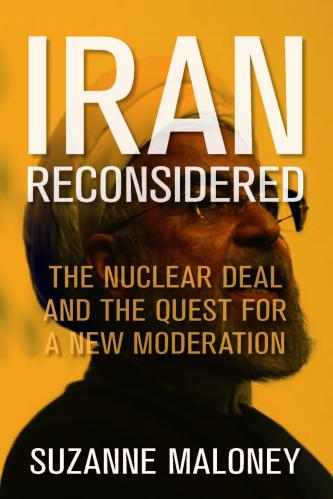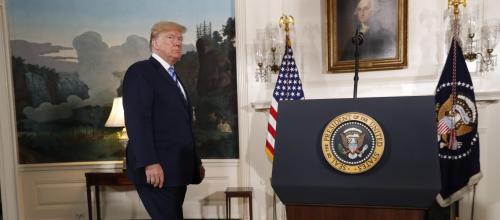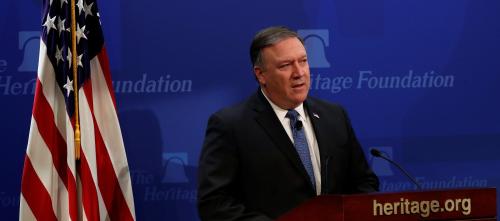The Trump administration is pushing its “maximum pressure” campaign against Iran into overdrive, with Tuesday’s announcement that the State Department is aiming to cut off all Iranian oil exports by November. As this move underscores, Washington has abandoned the fig leaf of diplomacy proffered by Secretary of State Mike Pompeo last month on the heels of President Trump’s decision to jettison U.S. adherence to the 2015 nuclear deal with Iran. Instead, the White House is embarking on an economic offensive intended to collapse the Iranian government, which is already contending with a steady tempo of internal unrest driven by economic and political frustrations.
This strategy conjoins the two defining principles of Trump’s Middle East policy: the conviction that Iran lies at the root of all the region’s crises and the aversion to committing additional American lives or treasure to ameliorating them. In what may be the supreme irony of Trump’s corrosive unilateralism, a president who has vilified his predecessor’s legacy and sought to undo its vestiges as expeditiously as possible has adopted precisely the same logic on the Middle East to produce its mirror image as policy. Both administrations identified Iran as the alpha and the omega for advancing regional security, and concluded that a shrewd American gambit—the nuclear deal for Obama, regime change for team Trump—could deliver the most bang for the buck. Those who have lamented Obama’s restraint in the Middle East will now have another taste of its antithesis: the purposeful American disruption of the status quo underpinned by the assumption that things can only get better. Unfortunately, that rarely holds true in the Middle East. Iran, and the world, are in for a bumpy ride.
Trump’s uncompromising sanctions enforcement will deepen Washington’s falling-out with allies in Europe, who initiated the nuclear diplomacy with Tehran and deeply resented Trump’s unilateral withdrawal from the deal. And it sets the stage for a risky showdown over sanctions enforcement with China, India, and other Asian importers of Iranian crude. While there is sufficient supply to cushion some drawdown in Iranian exports, oil prices spiked on the news at the height of U.S. summer travel season, and going for broke on sanctions in the midst of the brewing trade war between Washington and Beijing could have a calamitous effect on global markets.
The hammer comes down
Tuesday’s U.S. statement came via a background briefing with an anonymous State Department official offering more specific guidance on the president’s May 8 promise to begin “instituting the highest level of economic sanction.” The scope and complexity of the U.S. sanctions regime—as well as the open criticism of the decision from most other governments—left considerable ambiguity around the edges.
The remarks reinforced other signals suggesting that the Trump administration intends significantly harsher enforcement of the broad sanctions targeting Iran’s financial system that are coming back into force as a result of Trump’s abandonment of the nuclear accord. Ultimately, Iran will pay the price of efforts to reduce its revenues, but countries around the world—including key American allies and partners—already find themselves in the crosshairs, since the U.S. measures penalize countries and companies that do business with Iran.
It’s not just oil: U.S. sanctions will be felt across every aspect of the Iranian economy, although in theory, agricultural products, medicines, and medical devices are exempted. In practice, the repercussions are sweeping and unpredictable, and as the first of two U.S. deadlines for winding down business with Iran approaches, the creeping uncertainty about the future has fueled a spectacular plunge in the value of Iran’s currency.
The Trump administration has warned that Washington intends to show no restraint in enforcing the measures. Earlier this month, Sigal Mandelker, a senior U.S. Treasury official, warned U.S. allies and partners:
“[T]he Iranian regime will deceive your companies, undermine the integrity of your financial systems, and put your institutions at risk of our powerful sanctions, all to fund terrorism, human rights abuses, and terrorist groups. … You must harden your financial networks, require your companies to do extra due diligence to keep them from being caught in Iran’s deceptive web, and make clear the very significant risks of doing business with companies and persons in Iran.”
Notably, she highlighted the risks involved in providing landing rights or airline services to Iranian aircraft. This summoned the specter of a humiliating incident earlier this year, when German companies refused to refuel the government plane that carried Iranian Foreign Minister Javad Zarif to the Munich Security Conference.
America alone
The primary U.S. tool for reducing Iran’s oil revenues is contained in legislation signed by President Obama in late 2011, barring transactions with Iran’s Central Bank and other Iranian banks. The measure helped cut Iran’s oil exports by more than half over the subsequent 18 months, and blocked Iranian access to much of the income earned from the remaining sales.
That steep decline in 2012-13 was facilitated by robust cooperation between Washington and other world powers—the result of years of assiduous diplomacy—around the threat posed by Iran’s nuclear activities and the need for a negotiated resolution. On that basis, U.S. allies imposed complementary sanctions on Iran, most notably the European Union’s embargo on imports of Iranian oil that in one fell swoop deprived Iran of a destination for one-fourth of its exports. The Obama administration also calibrated its demands on oil importers, using waivers to encourage tapered drawdowns in supply from Iran to minimize economic strains and diplomatic frictions.
This time around, Washington has chosen to go it alone on Iran, after an intense but ultimately fruitless effort by Britain, France, and Germany to devise a compromise to save the nuclear deal. That awkward episode, in which the president appeared wholly uninformed about the talks, was a feature, not a bug; spurning compromise is the modus operandi for U.S. policy toward Iran, as the latest U.S. statements ruling out sanctions waivers or exemptions make clear.
The Trump administration is deploying U.S. sanctions on Iran as a bludgeon rather than a scalpel in hopes of wreaking maximum havoc on Iran as quickly as possible.
Now, without the reinforcement of multilateral measures or broad diplomatic support, the Trump administration is deploying U.S. sanctions on Iran as a bludgeon rather than a scalpel in hopes of wreaking maximum havoc on Iran as quickly as possible. The financial measures targeting Iran effectively cast a much wider net than traditional trade sanctions, and the risk of steep fines or worse—loss of access to the U.S. economy—acts as a powerful deterrent for individual and firm decisionmaking even in the absence of government buy-in.
American allies and partners are scrambling to devise measures to insulate existing trade and contrive some alternatives, but that’s unlikely to sustain even the modest economic ties with Iran that were re-opened by the 2015 nuclear deal. In the weeks since Trump’s withdrawal from the Joint Comprehensive Plan of Action (JCPOA), companies have been rushing to exit Iran, mammoth contracts for hundreds of new airplanes have been scuttled, and nearly all of the signature investments by European and Asian firms have already shifted into wind-down mode. In a move that many Iranians viewed as a gratuitous affront, Nike reportedly even declined to provide cleats for the World Cup matches of Iran’s beloved national soccer team, citing U.S. sanctions.
Can Trump’s blunt strategy work?
While the Obama administration could deal a major blow, quickly, to Iran’s oil markets, Trump will have a harder time. Over the past decade, technological breakthroughs have brought significant new sources of supply online and the cash-hungry Saudi government will eagerly step in by ramping up supply to snatch some revenues and market share from its toughest adversary. Still, with disruptions limiting a number of other suppliers, replacing anywhere close to all of Iran’s exports—which have reached as high as 2.7 million barrels per day earlier this year—would almost certainly mean tighter energy markets, intensified volatility, and significant cost to the global economy.
Iran sends its largest oil volumes to China and India, where diverse and reliable energy supplies are critical components of economic growth and national security. Both governments can draw upon ample access to bespoke financial institutions and other creative workarounds that sustain trade with Iran and are likely to seek to exploit the opportunity to press Iran for discounts and favorable payment arrangements. Even the attempt would seem to countermand Washington’s domestic political imperatives to maintain low oil prices in an election year, as well as Trump’s own tweets rebuking producers for high oil prices. As Iran’s OPEC governor, Hossein Kazempour Ardebili, observed: “You cannot place sanctions on two OPEC founder members and still blame OPEC for oil price volatility. … this is business, Mr. President—we thought you knew it.”
Indian officials are reportedly preparing to reduce imports from Iran, but as my colleague Tanvi Madan has explained, the domestic political implications of rising oil prices loom large for the Modi government. Meanwhile, the Trump administration’s demand that Beijing zero out oil imports has drawn open derision from analysts and a polite brush-off from the Chinese foreign ministry, whose spokesman this week described China’s relationship with Iran as “friendly” and its economic and energy ties as “beyond reproach.”
Through Tehran’s eyes
Through considerable internal turmoil and external conflicts, Iran has been a mainstay of global energy markets for a century; the only previous sustained rupture in Iranian supply came at the hands of a British embargo in 1951-53. That blockade ended with official American conspirators helping to effect the ouster of a troublesome Iranian leadership. At the time, this seemed like a victory for Washington; over the long term, that U.S. intervention to topple nationalist prime minister Mohammad Mossadeq proved to be a disaster for American interests and for Iran.
The Islamic Republic has no Mossadeq, but its current leaders have few good options to break the U.S. siege. There is at least some debate within the establishment about how to manage the American brinksmanship, but for now, the regime seems to prepared to try to wait out the indignities emanating from Washington. Ironically, for Tehran, American maximalism raises the stakes, but it also may lower the bar. The revolutionary system has survived successive crises, and a formula of repression, smuggling, and tactical cooperation with other world powers may enable the regime to muddle through yet again.
Make no mistake: This is no panacea either for the massive toll the sanctions will inflict or the preexisting distortions of corruption and mismanagement that plague Iran. American pressure coincides with, and will surely exacerbate, a surge of domestic discontent, which is the Islamic Republic’s real vulnerability. However, America’s open antagonism provides Tehran with another excuse to intensify repression and divert blame for the country’s woes. For Iran’s embattled leadership, survival is tantamount to success.
While the White House may be aiming for Iran’s implosion, a stalemate that slowly bleeds Tehran probably offers a satisfactory back-up plan for an administration whose bluster eclipses its tangible foreign policy gains. Already, with scant corroboration, the president has exulted that since he abrogated the Iran nuclear deal, “Iran is acting a lot differently. … They’re no longer looking so much to what’s going on in Syria, what’s going on in Yemen and lots of other places. They’re a much different country over the last three months.” In the short term, both Trump and Tehran may settle into a standoff that enables both sides to claim some measure of victory. Unfortunately, however, that’s not a stable equilibrium, and with impulsive leaders engaged an array of explosive conflicts, the American-Iranian impasse is almost certain to escalate.






Commentary
Trump tightens the screws on Iran’s oil
Is the U.S. aiming for regime collapse?
June 29, 2018